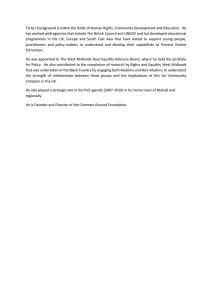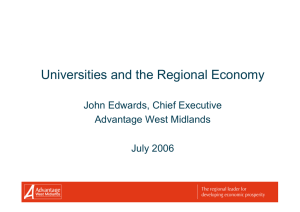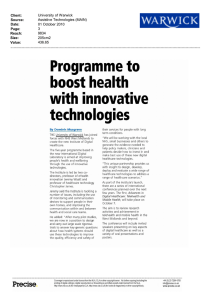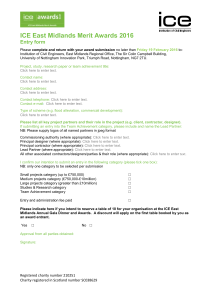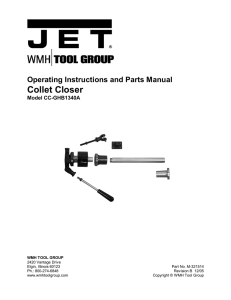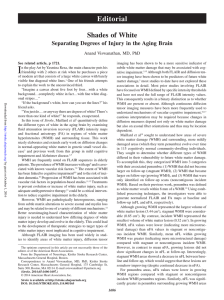Swimming Upstream: Inter-Professional Learning provides the key Colin Thunhurst PhD
advertisement
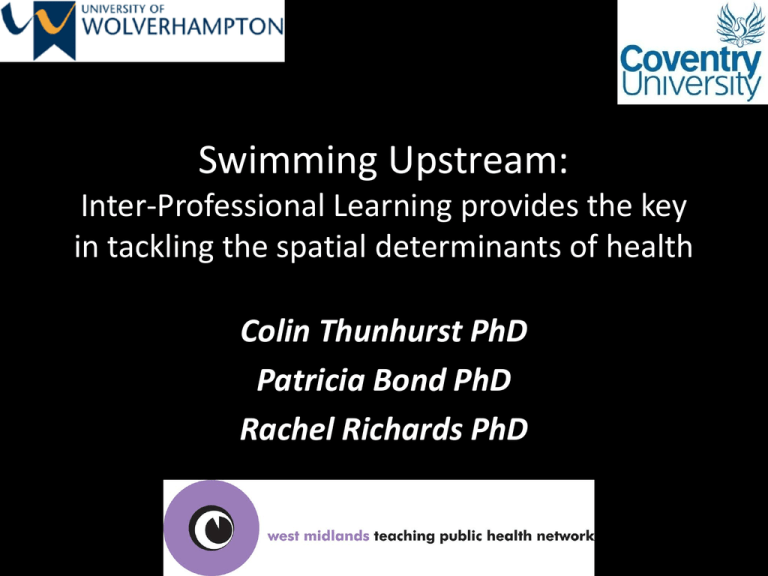
Swimming Upstream: Inter-Professional Learning provides the key in tackling the spatial determinants of health Colin Thunhurst PhD Patricia Bond PhD Rachel Richards PhD Outline • West Midlands Health & Wellbeing Strategy • Mapping the relationship with the Regional Spatial Strategy • Inter-sectoral Action requires InterProfessional Learning • Opportunities for Inter-Professional Learning • Beyond Learning to Action – organisational implications Acknowledgements • In this presentation we will be drawing upon work that we have undertaken for the DoH West Midlands on behalf of the West Midlands Teaching Public Health Network • Thanks to Rowena Clayton (DoHWM), Ginder Narle (WMTPHN), Cathleen Manancourt (WMTPHN) and other colleagues in WMTPHN West Midlands Teaching Public Health Network West Midlands Teaching Public Health Network Our Vision To increase the standard, range and availability of public health training in the West Midlands, in order to improve the health of the region’s population The National Lead on: Inter-professional learning (IPL) in public health Engaging partners Ethnic minority health West Midlands Health and Wellbeing Strategy adopts an upstream model Health analysed through underlying determinants rather than ‘priority issues’ • • • • • • Planning Transport and Health Housing and Health Environment and Health Economy Skills and Health Culture Leisure and Health Safer and Stronger Communities Mapping and Aligning Policies at the Respective Levels Objectives of the West Midlands Regional Spatial Strategy (WMRSS) and the West Midlands Health & Well-being Strategy (WMH&WS) Health Inequalities WMH&WS Planning Transport & Health Housing & Health Environment & Health Economy Skills & Health Culture Leisure & Health Safer and Stronger Communities Social Inclusion Demographic Change Mental Health Communities for the Future WMRSS Urban Renaissance Rural Renaissance Diversifying and Modernising the Economy Modernising the Transport Infrastructure Prosperity for All Quality of the Environment Accessibility Mapping the Objectives of the West Midlands Regional Spatial Strategy (WMRSS) and the West Midlands Health & Well-being Strategy (WMH&WS) at the macro level Cross-cutting Themes Health Inequalities WMH&WS Children Young People and Families Planning Transport & Health Housing & Health Environment & Health Economy Skills & Health Culture Leisure & Health Safer and Stronger Communities Later Life +/+/- Social Inclusion Demographic Change Mental Health +/- + + +/Cross-cutting Themes Communities for the Future WMRSS Urban Renaissance Rural Renaissance Diversifying and Modernising the Economy Modernising the Transport Infrastructure Prosperity for All Quality of the Environment Accessibility Key: + indicates WMRSS supports objectives of WMH&WS - indicates WMRSS conflicts with objectives of WMH&WS +/- indicates WMRSS may either support or conflict with objectives of WMH&WS Mapping the Objectives of the West Midlands Regional Spatial Strategy (WMRSS) and the West Midlands Health & Well-being Strategy (WMH&WS) at the micro level Cross-cutting Planning Transport & Health Themes WMH&WS Children Young People and Families Improved Accessibility Increased Social Inclusion More Active Transport Less Road Accidents Less Air Pollution/ Noise Later Life Improved Built and Natural Environment Enhanced Community Participation and Partnership Working Health Inequalities Social Inclusion Demographic Change Mental Health All T12: Priorities for Investment Key: + indicates WMRSS supports objectives of WMH&WS - indicates WMRSS conflicts with objectives of WMH&WS +/- indicates WMRSS may either support or conflict with objectives of WMH&WS T11: Airports T10: Freight T9: Management and Development of Transport Networks T8: Demand Management T7: Car Parking Standards and Management T6: Strategic Park & Ride T5: Public Transport T4: Promoting Travel Awareness T3: Walking and Cycling T2: Reducing the Need to Travel T1: Developing Accessibility and Mobility WMRSS Modernising the Transport Infrastructure Cross-cutting Themes Communities for the Future Prosperity for All Quality of the Environment Accessibility From Mapping to Shaping Inter-Professional Learning • A full understanding of the inter-relationship requires a developed systems mapping exercise (in the manner of the Foresight Report) • However, more important than achieving an ‘accurate’ representation is establishing a medium, through which public health practitioners and spatial planners institute and maintain regular dialogue •Inter-professional Learning The health dividend relies on seeing the big picture and the detail at the same time “Devil in the detail”: The challenge • Develop a fully shared purpose – Build mutual understanding – Appreciate the scope of each others areas of work • Build mutual goals into core business plans • A “regional” understanding Vision: to strive beyond “the accepted” to “what might be possible” • The potential for new conceptual models of healthy urban planning • New patterns of connection, collaboration and alignment • New ways of sharing knowledge • Communities of practice What could help? Additional principles and pre-requisites need embedding in the system: 1. A commitment to seeing these regional strategies as a continuous process 2. A commitment to build relationships 3. A commitment to collective action • as a holistic process • that recognizes the many disciplinary and professional interests of the collective. Inter-sectoral strategy development requires Inter-Professional Learning • Interprofessional education has been defined as "occasions when two or more professions learn from and about each other to improve collaboration and the quality of care" (CAIPE 1997). • Based on the principles of organizational and educational psychology it provides a pedagogic model to underpin service realignment and integration • IPE is not about "dumbing down" disciplinary intervention; neither is it about multiskilling. Rather it is a process that offers continuity and facilitates ongoing trust among professionals Opportunities: IPL • A Common set of professional values relating to public sector governance • A history of interdisciplinary working • The shared goal of creating “sustainable communities”. • No national overview of healthy urban planning skills • A Shortage of competencies to support the sustainable community agenda (Egan Review , Association for Sustainable Communities) • Absence of generic skills training • Collaborative working, Project management, Public engagement. Advancing Inter-professional Learning • Tools exist to assess the health implications of planning applications • Professional bodies are on board • The professions have comparative CPD requirements • The sustainable skills agenda could provide common IPL content • Opportunities for IPL at prequalifying levels are scant Inter-sectoral strategy development requires Inter-Professional Learning • Translating IPL into practice is a complicated exercise, requiring: – models of service planning that allow for measurement of change, as a function of the collaborative (teamwork) experience. – Structures that facilitate IPE for collaborative practice – Stability and sustained action Organisational Implications • Moving out of our silos – Organisational Alignment – Institutional commitment – From supportive partnerships to active joint working • Breaking down the barriers between statutory agencies and third sector organisations Contacts • Colin Thunhurst c.thunhurst@coventry.ac.uk • Patricia Bond P.A.Bond@wlv.ac.uk • Ginder Narle ginder.narle@nhs.net
